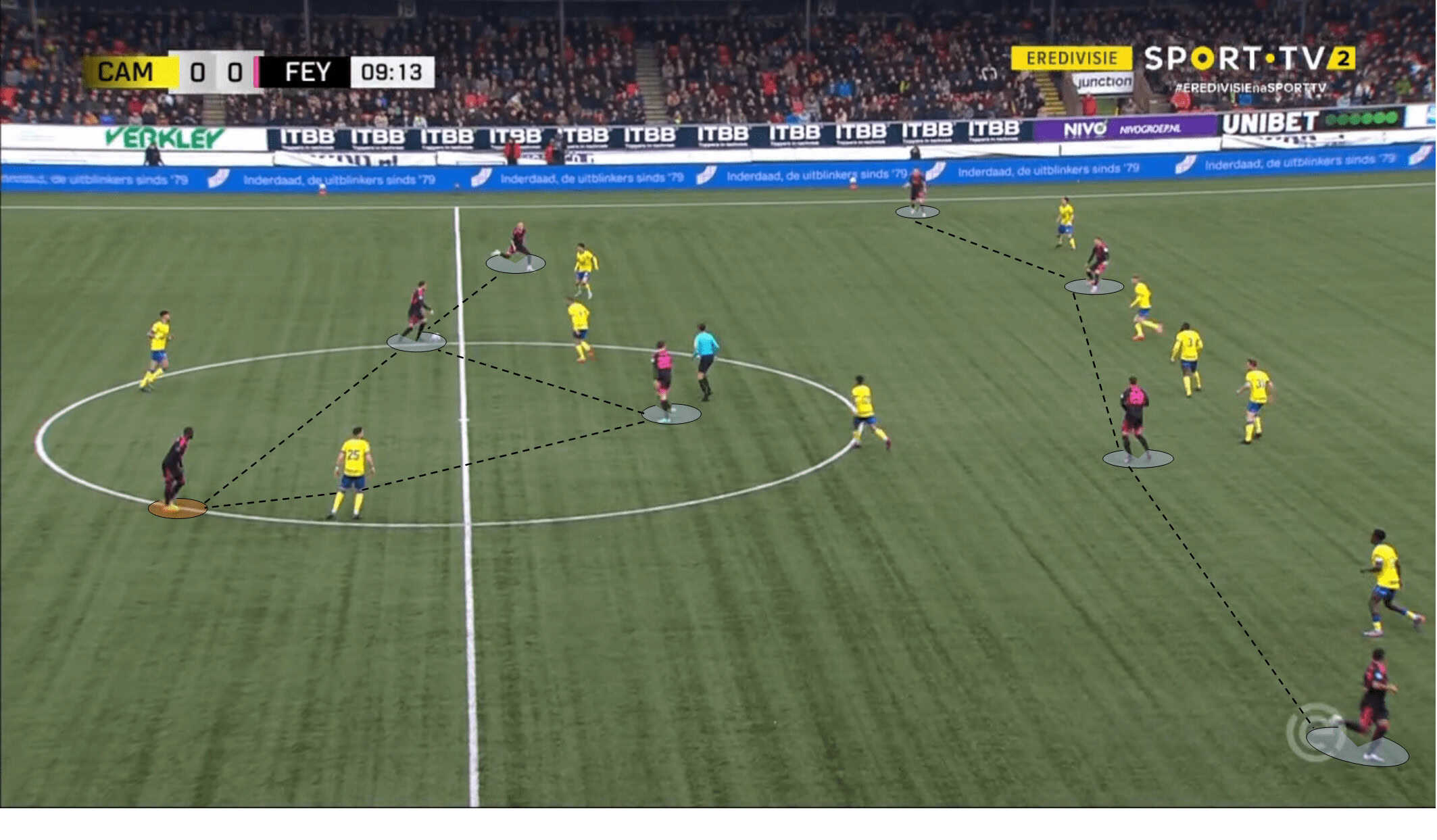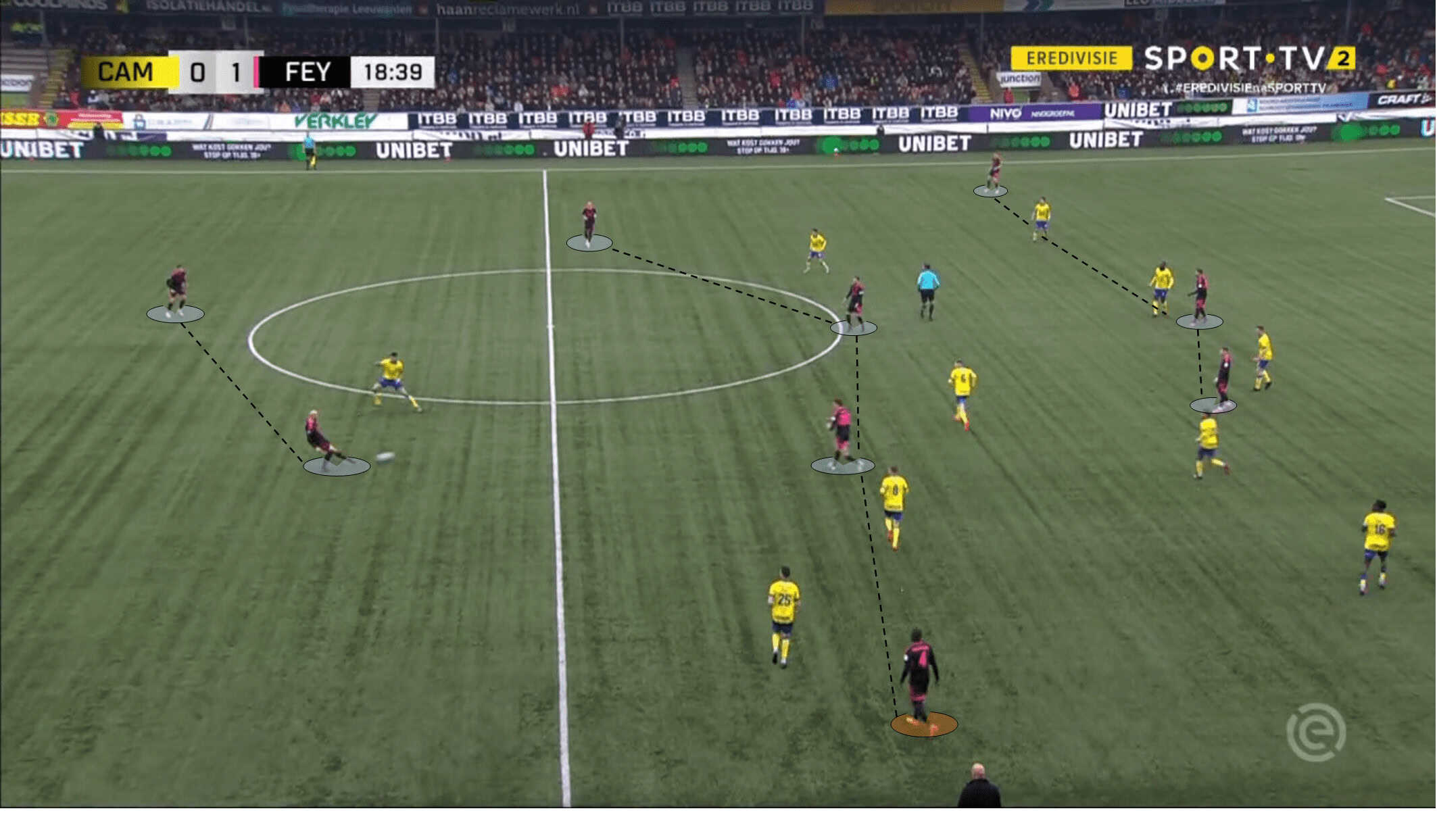Over the years, the fullback role, regarding its positioning, has suffered several changes. A few decades ago, the fullback’s main function was to support the team defensively, helping to not concede any goals. Only after the team was assured defensively, the fullback was allowed to intervene in the offensive process.
However, some teams began to use their fullbacks as players that were able to support the attack. In other words, the fullbacks started to position themselves wide open in more advanced areas. With this kind of positioning, not only can they force the opposite team to drop their own defensive line but also it allows the wide defender to link up with the winger, midfielders and more importantly the striker, through more precise crosses.
Yet, there is a relatively recent tactical current regarding the fullbacks’ positioning, called “inverted fullbacks”. This role was primarily conducted by Johan Cruyff in Barcelona but was Pep Guardiola the one who took these tactics into modern football, especially in teams like Bayern Munich and Manchester City.
However, with some variations as we are going to see further, this kind of positioning basically consists of the player positioning himself in the middle as a second midfielder helping the team to dominate the midfield area. While, defensively, everything goes back to normal with the player dropping back into the backline of four. In order to succeed in this kind of function, one must have a very good understanding of this tactical theory, so that it can be possible to perform well inside or out wide.
Besides that, excellent technical quality is also needed either to break lines and make simple short passes or to dribble past opponents. For instance, at Bayern, Pep had some outstanding players who met those requirements like Philipp Lahm, David Alaba and even Joshua Kimmich.
Although other coaches also started to play with inverted fullbacks, they made their own analysis and adapted it to their own game model, creating some different approaches. In this tactical analysis, we will try to enlighten some different variants, by some top teams.
Arsenal
Let’s start with the current leaders in the Premier League, Mikel Arteta’s Arsenal. As we know, Arteta spent some years being Guardiola’s assistant coach at Manchester City and naturally took out some of City’s ideas, adapting them to his current team. One of them is the necessity for having the ball as long as possible to hurt the opposition, and the use of inverted fullbacks is a good tool for that, simply because it gives more strength to the midfield.
The other main idea behind Arsenal’s moment of organisation is the mobility and the necessity of having the right spaces occupied by the right players. In Arsenal’s model, the left-back, normally played by Zinchenko, performs as an inverted fullback, whereas the right-back (Ben White) often intervenes in the build-up as a centre-back.
So, Arsenal has two main build-up structures, with three men (composed of Gabriel, Saliba/Holding and Ben White) and with two men (Saliba/Holding and Gabriel).
Let’s start with the three-man build-up. As we can see below in the figure, Tierney explores the space inside, giving the flank to Martinelli, Gabriel Jesus or Granit Xhaka. These three players are always in such mobility that we can see them both inside or outside always looking for the free space. This kind of mobility misguides the opposite team’s pressing plan and it creates even more space to play in the organisation.


As an alternative, Arsenal also builds up with two men, and this process has two phases. Firstly, Gabriel and Holding or Saliba (currently injured) stay at the back, relatively wide, and both Tierney and Ben White are also wide open, creating free space in the middle for Xhaka, Gabi and Ødegaard. Saka and Martinelli are normally deep on the field and wide open.

However, Arsenal are a very flexible team regarding positioning and suddenly, as shown below, Tierney searches for space inside, changing his teammates’ placements on the field. Martinelli drops deeper on the pitch, giving a solution near Gabriel and Xhaka, and Ødegaard looks for space deeper between the lines. Besides that, there are moments where Xhaka offers a solution behind Martinelli who is no longer deep on the field.

Liverpool
Like Arsenal, Liverpool only uses one of the fullbacks as an inverted fullback. In this case, we are talking about Trent Alexander-Arnold. He is a player with outstanding technical quality, especially with his passing, and when he plays that role, he has the ability to find his teammate between the lines, breaking them easily.
Trent is neither a very explosive nor a quick player, and when played as a traditional fullback, offers serious concerns, especially in transitions. So, this change in Trent’s role was a very clever move from Jurgen Klopp because he can take out the best qualities from him at that specific position while the team is in possession.
In the build-up, Trent is positioned right near Fabinho, giving him a solution between the attackers and midfielders. On the other hand, the left back, Andy Robertson, who is more limited technically, in the initial phase helps the team build up by dropping next to Virgil Van Dijk, forming a three-man line.

As we can see from both below images, Mohamed Salah is positioned deep and open on the right flank, while Curtis Jones or Diogo Jota are occupying the space on the left. Due to this constant mobility and space occupation, Leeds’ right midfielder was badly positioned and Curtis receives the ball with no pressure from the opposition.


Borussia Dortmund
It’s common for football coaches to adapt their game model to the squad they have available. In this case, Edin Terzic adapted his left-back’s (Raphael Guerreiro) role in relation to the moment of the game they are in. In other words, Guerreiro’s role is as a hybrid left-back, where in some moments he is wide-open and in others he is inside, playing as an inverted fullback. For example, Dortmund is a team that likes to build from the back (2-3-2-3) whereas Raphael usually is wide open, giving solutions to Hummels. He can be very useful in this moment of the game due to his good dribbling to bypass opponents or even due to his good passes, finding open teammates.

The Portuguese defender is comfortable playing in more interior zones of the pitch as an inverted left-back because he’d already performed as a midfielder in previous seasons, not only due to his distinctive technical ability but also due to his know-how in understanding the game in possession.
Therefore, it is wise to give Guerreiro positional freedom as an inverted fullback to explore more interior zones of the pitch and take advantage of his efficiency in the last third of the pitch. In fact, despite his physical disadvantages, he is currently the defender with the most goal contributions in Europe’s top leagues, with 15 in 23 games.


Another aspect that is interesting about Dortmund’s organisation has to do with Guerreiro’s positioning while he’s open in the opposition’s midfield. In fact, he doesn’t use the maximum width of the pitch. Instead, he positions himself in the halfspace between the midfielder’s and the winger’s sectors. This is very positive to his performance because with that positioning, he has several more options to go for than if he was right next to the touchline.

Feyenoord
We used two Feyenoord games to analyse their fullbacks’ behaviour, one against the Serie A side Roma, and the other against the last-placed team in Eredivisie, Cambuur.
Let’s start with the game against Roma where Arne Slot’s Feyenoord, in the offensive organisation, presented themselves in a 2-4-3-1, which, in contrast with the other systems, used both of the fullbacks inverted.
In fact, in the first instance, the fullbacks acted as defensive midfielders, leaving the flanks to the wingers. One of the reasons that explain this positioning could be to be more secure during defensive transition. As we know, Roma, and especially Mourinho’s teams in general, are known for their effective and lethal counterattacks, and with the fullbacks positioned inside, Feyenoord increased the number of players in the midfield area and can have far more possibilities of winning a larger number of duels, preventing Roma’s transitions. Besides that, it also misguides Roma’s pressing plan.

Against Cambuur there was no need to have both of the fullbacks inside preventing the counterattack because they were a much inferior team than Roma in all aspects. So, instead, Feyenoord only played the right back (Geertruida) as an inverted fullback, using the left back (Hartman) as a traditional fullback, supporting the attack from the outside.
Geertruida’s positioning depends mainly on the number 20 (Wieffer), where, if he is in a more offensive zone as we can see, the right-back is able to occupy the interior space near Kokcu, while Igor Paixão positions himself wide on the right flank.

Otherwise, whenever Wieffer occupies the central midfield zone, Geertruida stays open on the right flank, giving space for Igor between the lines.

Conclusion
So, the use of inverted fullbacks can be explained mainly by three factors; to win more duels in the midfield zone, preventing counterattacks from the opposition, to misguide the opposition’s pressing plan by occupying different spaces with different players and finally, to take advantage of talented players with excellent tactical intelligence.
However, it is rare to find a fullback capable of having consistently good performances in this role due to the high tactical and technical demand. With that being said, not all teams are able to perform with an inverted fullback.






Comments